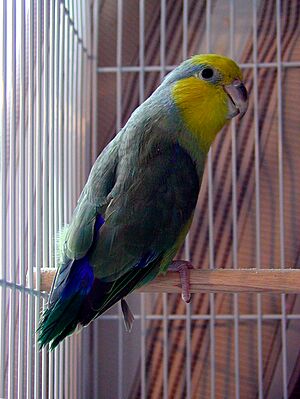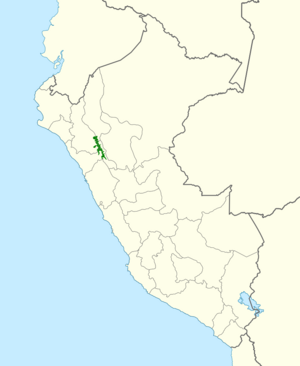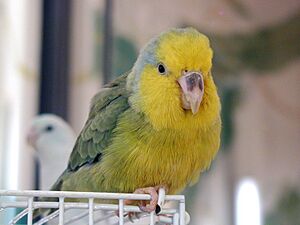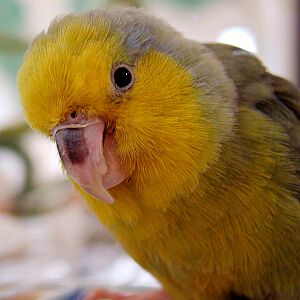Yellow-faced parrotlet facts for kids
Quick facts for kids Yellow-faced parrotlet |
|
|---|---|
 |
|
| Adult male | |
| Conservation status | |
| Scientific classification | |
| Genus: |
Forpus
|
| Species: |
xanthops
|
 |
|
The yellow-faced parrotlet (Forpus xanthops) is a small, colorful parrot. It belongs to the Psittacidae family. These birds are known for their bright yellow faces. They live in a specific part of Peru.
Contents
What Do They Look Like?
Yellow-faced parrotlets are about 14.5 centimeters (5.7 inches) long. They weigh around 35 grams (1.2 ounces). Their bodies are mostly dark or olive green. They have gray on their neck and back. Their bellies are yellow-green.
The front of their heads, cheeks, and throats are bright yellow. A gray-green stripe goes back from each eye. Their eyes are dark brown. Their feet and lower beaks are light peach. The top part of their beak is light peach with a darker base.
Male and female parrotlets look a bit different. This is called sexual dimorphism. Males have bright blue lower backs, tails, and wing feathers. Females have lighter blue feathers on their backs. Their wing feathers are blue-green.
Young parrotlets look like adults. But they are not as bright. They have fewer yellow feathers. Their beaks are completely peach.
Like all parrots, yellow-faced parrotlets have special feet. They have two toes pointing forward and two toes pointing backward. This is called zygodactyly. It helps them grip branches and climb.
Where Do They Live?
Yellow-faced parrotlets live in northwestern Peru. You can find them in the upper Rio Marañón valley. This area stretches from eastern La Libertad up to southern Amazonas.
These parrotlets like dry, open woodlands. They live in tropical and subtropical areas. Their homes include scrubland and areas near rivers. They also live in open forests with balsa trees. You can find them in cactus deserts and open areas with scattered plants. They usually live at heights of 800 to 1000 meters (2,600 to 3,300 feet) above sea level. Sometimes, they are found as high as 2400 meters (7,900 feet).
How Are They Protected?
The yellow-faced parrotlet is listed as a Vulnerable species. This means they are at risk of becoming endangered. The IUCN Red List keeps track of this. In 2016, there were an estimated 250 to 999 adult birds in the wild.
Threats to Their Survival
Their population is currently stable. However, these birds are often caught for the wild parrot trade. Many birds die during this process. It is thought that 40% to 100% of trapped birds do not survive. Building dams on the Rio Marañón is also a danger. Human activities often harm their natural homes.
Yellow-faced parrotlets are protected by law. Selling them internationally is against the rules. This is thanks to laws like the Wild Bird Conservation Act.
Behavior and Life Cycle
Social Life
Yellow-faced parrotlets are very social birds. They often gather in large groups. Flocks of up to 70 pairs sleep together.
Their calls are quiet tweets and chirps.
Reproduction
Yellow-faced parrotlets usually breed in March and April. Females lay clutches of 3 to 6 small white eggs. A clutch is a group of eggs laid at one time. These parrotlets do not build nests. Instead, they chew wood shavings. They arrange them into shallow dips on the ground.
What Do They Eat?
Yellow-faced parrotlets mostly eat fruits from cactus plants and trees. They also enjoy seeds, flowers, and grass. Wheat seeds are another favorite food.
Parrotlets in Captivity
Yellow-faced parrotlets are very rare to see as pets. This is because they are a vulnerable species. Sadly, illegal pet traders still catch wild birds. This practice is not very profitable. It also comes with serious punishments.
There are fewer than 50 yellow-faced parrotlets in captivity in the U.S. This is just an estimate. These birds are easy to breed in captivity. This helps groups like the International Parrotlet Society. They run successful breeding programs. These programs help to conserve this species.




